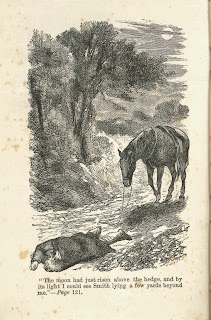 If a horse could tell his own story, what would he say? Anna Sewell embraced this challenge when she “translated” the story of Black Beauty in her famous novel, Black Beauty: His Grooms and Companions: The Autobiography of a Horse (London: Jerrold and Sons, 1877). The first edition, bound in green cloth and stamped in black and gold, sold quickly in Victorian England; no one had read a story from an animal’s perspective before. Since it was published in 1877, Black Beauty has become one of the world’s most popular books, selling more than fifty million copies and inspiring a slew of movies, plays, and stories told from an animal’s point of view.
If a horse could tell his own story, what would he say? Anna Sewell embraced this challenge when she “translated” the story of Black Beauty in her famous novel, Black Beauty: His Grooms and Companions: The Autobiography of a Horse (London: Jerrold and Sons, 1877). The first edition, bound in green cloth and stamped in black and gold, sold quickly in Victorian England; no one had read a story from an animal’s perspective before. Since it was published in 1877, Black Beauty has become one of the world’s most popular books, selling more than fifty million copies and inspiring a slew of movies, plays, and stories told from an animal’s point of view.Anna Sewell wrote Black Beauty with a specific purpose: improving animal rights. As she writes in the novel’s dedication, Sewell was “devoted to the welfare of others.” After growing up with injuries and diseases that limited her ability to walk, Sewell became invested in the lives of the horses upon whom she depended every day. Beauty, the narrator, may even be based on one of the Sewell family horses--an opinionated black mare named Bess. Not only does Black Beauty capture the centrality of horses in Victorian life, from the transportation of people and goods to war, style, and sport, it also gives its characters an emotional complexity that resonates with both juvenile and adult readers.
The best-selling first edition, published just five months before Sewell’s death, had a widespread impact on the early animal rights movement, both in its native England and the United States. While Sewell includes a note at the end of this edition, in which Black Beauty’s “Translator” asks the reader to learn and practice proper animal care, it is Beauty's stories that have the most impact. With both humor and heartbreak, he describes kind treatment and cruel abuse, along with practices that harmed horses for the sake of fashion, like the bearing reins that forced carriage horses to hold their heads unnaturally high. Black Beauty, and the movement it inspired, produced the first legislation that would begin to curtail practices like this, and the abuse of animals in general.
There is no religion without love, and people may talk as much as they like about their religion, but if it does not teach them to be good and kind to man and beast, it is all a sham.
--Black Beauty
To follow Beauty on his journey, ask for Rare PR 5349.S427 B6 1877.
Posted for Emily Estelle '15.

No comments :
Post a Comment